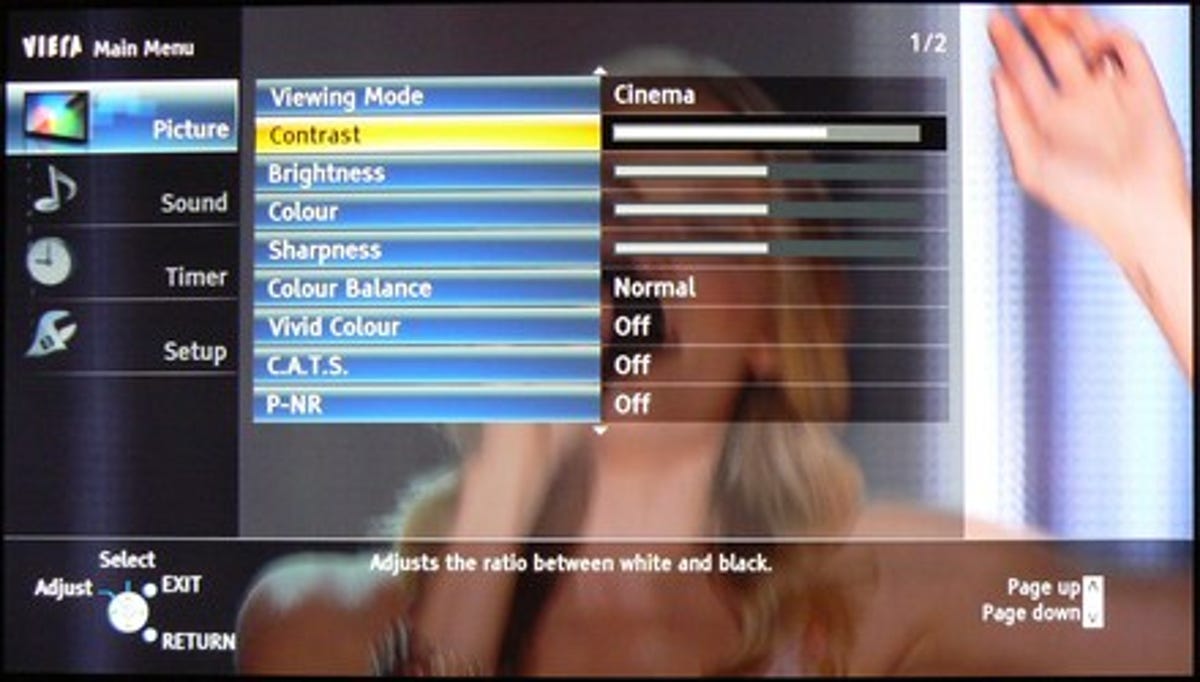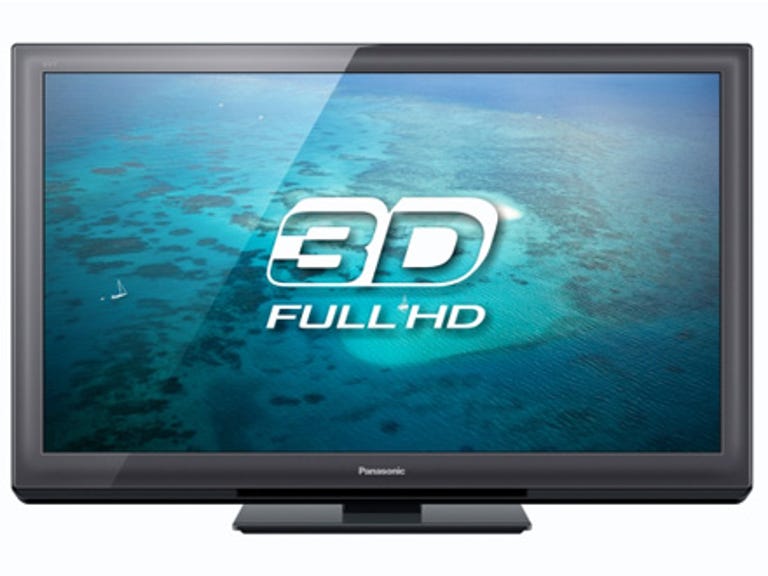 Why You Can Trust CNET
Why You Can Trust CNET Panasonic Viera TX-P42ST30B review: Panasonic Viera TX-P42ST30B
The Panasonic TX-P42ST30's deep black levels and perky colours help its 2D and 3D pictures stand out from the crowd.
Panasonic's P42ST30 sits below the top of the range VT30 and mid-tier GT30 models in the company's current line-up of 3D plasma TVs, but above the recently announced UT30. It boasts many of the same features of the higher-end sets in the range, but lacks a Freesat HD tuner and media streaming capabilities. It is, however, available for a relatively low asking price of £600 online, which is around £200 less than the GT30 model.
The Good
The Bad
The Bottom Line
User interface and EPG
While the likes of LG and Samsung have done a lot of work to make the user interfaces on their TVs look as appealing as possible by using lots of neat animations, lashings of colour and cute icons, Panasonic is sadly yet to follow suit. In comparison to its Korean rivals, the menu system on this TV looks very bland.
For the most part the menus are quite static and boring, with the result that they feel out of step with most of the newer TVs on the market at the moment. Panasonic has added some icons in the main menu for the picture, sound, timer and set-up options, but the rest of the menus are predominantly rendered just as white text against a blue or black background.
On the plus side, the menu structure is logically laid out and easy to find your way around. And while this model lacks the ISF calibration tools and THX certification of the GT30 and VT30 models, there are still plenty of tweaking options available in the picture menu. Along with the usual brightness, contrast and colour controls, you'll also find numerous settings for the 3D features as well as the Intelligent Frame Creation modes.

This model does have a Freeview HD tuner, but lacks the Freesat HD tuner you get on the two higher end models. Like the menu presentation, the set's Freeview HD EPG also looks quite drab and dreary.
As with Panasonic's other models it uses the dreaded GuidePlus+ system. The main annoyance we have with this system is that it reserves space on the left-hand side of the guide for Web-style adverts. This compromises the amount of screen real-estate available for showing programming info. The large font Panasonic has used for programming info does, however, make it easily readable from across a room, and the EPG is responsive, so it's quick to jump to what's coming up on different channels.
Digital media and Internet features
When it comes to Internet and media playback features, this set is a mixed bag. The Ethernet port on the rear means that you do get access to Panasonic's VieraConnect system, which now includes BBC iPlayer alongside other useful services such as YouTube, AceTrax and Daily Motion.
There are also a number of news and information services including Accuweather and Euronews, and there are mini apps for social networking sites such as Facebook, Twitter and Picasa. All in all, it's a decent line-up of features, if not quite as impressively presented as Sony, LG or Samsung's offerings.
The set also has twin USB ports and an SD Card slot. The SD card slot lets you view 2D and 3D pictures and video shot on Panasonic cameras and camcorders, while the two USB ports support playback of a range of digital media formats including JPEG pictures, MP3 music files and movies in Xvid, DivX and MKV format.
Sadly, though, despite the presence of the Ethernet port, this model doesn’t support any network streaming, so you can’t stream files from PCs or DLNA servers across a network.
Also, unlike the VT30 and GT30 models, this set doesn't support USB recording from the onboard Freeview HD tuner. If you've already got a PVR, such as Sky HD, you're probably not going to miss this feature, as it's more of a handy extra than something that's advanced enough to negate the need for a secondary box, but it's still worth mentioning.
Design and connections
Whereas the GT30 and VT30 models have an updated, more appealing design, the ST30 relies on the same design that graced last year's Panasonic's models. The ST30 suffers on the aesthetic front as a result, because the design is rather lacklustre and, dare we say it, boring.
The screen is framed by a relatively thick grey bezel that has an interesting effect where, if the light hits it from the right angle, it actually looks like it has a contoured section in the middle, whereas in reality it's flat. The look is interesting, but not all that visually appealing, and there's little else in the TV's design to jazz up the design. So, compared to the slick styling of Samsung's and LG's plasmas, this set is disappointing.
At least the ST30 isn't found wanting when it comes to the range of connections on offer. The rear panel is home to three HDMI inputs, a single Scart socket, a set of component inputs and an optical digital audio output. There's also the RF input for the Freeview HD tuner and the Ethernet port that enables the Internet features.
Above this main panel you'll find a USB port, which is joined by a second USB port mounted on a side panel on the left-hand edge. This panel is also home to an additional HDMI port, a composite input and an SD card slot. One of the USB ports can also be used with the optional Wi-Fi dongle, if you'd prefer not to have an Ethernet cable running to your TV. The Wi-Fi dongle is pricey, though, costing £82 from the Panasonic online store.
2D picture quality
The ST30 is fairly well tricked-out on the processing front, with support for Panasonic's V-Real 3D system, Intelligent Frame Create Pro and 24p Smooth Film. Its panel also has the same High Contrast Filter as that found on Panasonic's GT30 model, which helps it to deliver deep black levels, although Panny's own VT30 still has the edge as it uses a newer and better contrast filter.
Nevertheless, this set's black levels are still hugely impressive and this, in combination with its excellent contrast performance, helps it pull plenty of detail out of the shadows of even the most noir-ish movies. Its colour palate is also bright and punchy, while managing to remain warm and natural looking. It delivers excellent levels of sharpness for HD material, and its upscaling circuitry does an excellent job of tarting-up standard definition channels on Freeview without making them look unnaturally crisp.
In fact, the only real downside is that you'll see banding on colours every now and again, where colours seem to step from one gradient to the next rather than blending seamlessly between hues, but this is something common to most plasmas.
3D picture quality
Like all Panasonic's 3D sets, this one relies on active 3D technology. As a result, the glasses are quite expensive, costing between £70 and £100 each, depending on where you buy them from. The glasses are a little on the heavy side and not hugely comfortable to wear. The set's 3D performance, however, is top notch. There's virtually no crosstalk (double imaging) visible on 3D images, which helps to increase the solidity of the 3D experience and makes the most of the impressive sense of depth. Also, despite the dimming effect of the glasses, the ST30's above average brightness levels help to keep pictures looking punchy.Audio quality
As with Panasonic's other recent flatscreen TVs, this model's chassis flares out at the bottom by around 25mm in order to provide extra room for its speaker drivers. This is a sensible move on Panasonic's part as many flatscreen TVs suffer from weedy audio due to the limited size of their speakers.
Thankfully, the ST30's larger speakers help it to rise above the pack in this regard. The set produces much deeper bass than most flatscreens around today -- something that helps to add a little more oomph to film soundtracks, especially action movies. The mid-range performance is strong too, so dialogue sounds bright and clean. It's not the loudest model you'll come across, but there is enough volume to fill a decent sized room at acceptable noise levels.
Panasonic has added in some sonic extras, including Volume Correction, which helps to avoid big jumps in audio levels between channels or between TV shows and ad breaks. There's also Panasonic's V-Audio Surround system, which aims to simulate surround-sound. Unfortunately, it doesn’t work all that well, only adding a small amount of extra width to the sound stage.
Conclusion
The TX-P42ST30 is a top-class set, and there's little difference between this and the GT30 in terms of picture performance. If the GT30's extra Freesat HD tuner and DLNA media streaming capabilities aren't of interest, the ST30 will save you £200 without making you suffer the indignity of having to put up with inferior picture quality.


